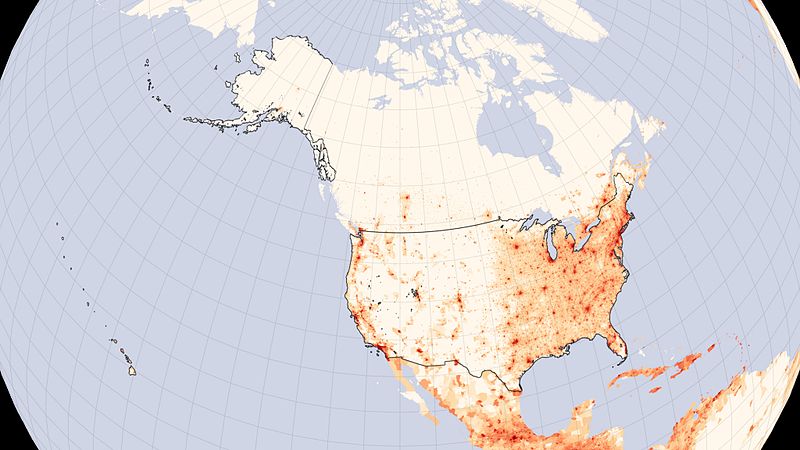Soubor:Us population 2005 lrg.jpg

Velikost tohoto náhledu: 800 × 450 pixelů. Jiná rozlišení: 320 × 180 pixelů | 640 × 360 pixelů | 1 024 × 576 pixelů | 1 280 × 720 pixelů | 2 048 × 1 152 pixelů.
Původní soubor (2 048 × 1 152 pixelů, velikost souboru: 442 KB, MIME typ: image/jpeg)
| Tento soubor pochází z Wikimedia Commons. Níže jsou zobrazeny informace, které obsahuje jeho tamější stránka s popisem souboru. |

|
Tento obrázek (skupina map) by měl být vytvořen pomocí vektorové grafiky jako SVG soubor. To má několik výhod; podrobnosti najdete na stránce Commons:Media for cleanup. Je-li SVG verze tohoto obrázku již k dispozici, prosím nahrajte ji. Po nahrání nahraďte tuto šablonu šablonou {{Vector version available|jméno nového obrázku.svg}}.
|
 | Tento obrázek (nebo všechny obrázky v tomto článku či kategorii) byl nahrán ve formátu JPEG, ačkoliv obsahuje informace, které mohou být efektivněji nebo přesněji uloženy ve formátu PNG nebo SVG. Pokud je to možné, nahrajte prosím variantu tohoto obrázku v PNG či SVG bez kompresních artefaktů buď z ne-JPEG zdroje nebo s odstraněnými kompresními artefakty. |
Popis
| PopisUs population 2005 lrg.jpg |
English: The population of the United States reached 300 million on October 17, 2006, said the www.census.gov/Press-Release/www/releases/archives/population/007616.html U.S. Census Bureau. With one birth every 7 seconds, a death every 13 seconds, and a migrant entering the country every 31 seconds, the United States' population is growing at a rate of one person every 11 seconds. Where are all of these people living? This map, based on population estimates made in 2005, charts out the number of people in every square kilometer of the United States. As has been the case historically, the most densely populated parts of the United States are east of the Mississippi River. Rings of decreasing population density radiate out from the major urban centers of New York, Philadelphia, and Washington along the East Coast. Other cities -- Atlanta, Chicago, Houston, and Dallas -- punctuate the map in the country's interior. The west remains lightly populated except for clearly defined urban regions. Like their counterparts in the east, the largest cities in the west (San Diego and Los Angeles in the south; San Francisco, Oakland, and San Jose farther north) hug the coast, with the densest populations in Southern California. Other large western cities readily visible here include Portland, Seattle, Phoenix, and Denver. For Earth scientists, population density maps can be crucial in answering questions about the relationship between people and the environment. How does population density relate to changes in land cover? How are natural resources distributed in relation to population? How do densely populated regions, with their pollution, artificial surfaces, and urban heat islands, affect climate? To answer these and other questions, scientists compare detailed population maps to other geographically based data sets, including satellite data. In the comparison, trends that track the human footprint can emerge. This particular population density map is based on a sedac.ciesin.columbia.edu/gpw/index.jsp global population density map created at the sedac.ciesin.columbia.edu/index.html Socioeconomic Data and Applications Center (SEDAC) at Columbia University. One of the Distributed Active Archive Centers in NASA's Earth Observing System Data and Information System, SEDAC provides information about human interactions in the environment.
|
| Datum | |
| Zdroj | http://earthobservatory.nasa.gov/IOTD/view.php?id=7052 |
| Autor | NASA -- NASA image by Robert Simmon, based on data archived by the sedac.ciesin.columbia.edu/ Socioeconomic Data and Applications Center |
Licence
| Public domainPublic domainfalsefalse |
| This file is in the public domain in the United States because it was solely created by NASA. NASA copyright policy states that "NASA material is not protected by copyright unless noted". (See Template:PD-USGov, NASA copyright policy page or JPL Image Use Policy.) |  | |
 |
Warnings:
|
Popisky
Přidejte jednořádkové vysvětlení, co tento soubor představuje
Položky vyobrazené v tomto souboru
zobrazuje
24. 10. 2006
Historie souboru
Kliknutím na datum a čas se zobrazí tehdejší verze souboru.
| Datum a čas | Náhled | Rozměry | Uživatel | Komentář | |
|---|---|---|---|---|---|
| současná | 4. 7. 2016, 00:24 |  | 2 048 × 1 152 (442 KB) | Proud User | User created page with UploadWizard |
Využití souboru
Tento soubor používá následující stránka:
Globální využití souboru
Tento soubor využívají následující wiki:
- Využití na en.wikipedia.org
- Využití na uk.wikipedia.org
Metadata
Tento soubor obsahuje dodatečné informace, poskytnuté zřejmě digitálním fotoaparátem nebo scannerem, kterým byl pořízen. Pokud byl soubor od té doby změněn, některé údaje mohou být neplatné.
| Orientace | Normální |
|---|---|
| Rozlišení obrázku na šířku | 72 dpi |
| Rozlišení obrázku na výšku | 72 dpi |
| Použitý software | Adobe Photoshop CS2 Macintosh |
| Datum a čas vytvoření obrázku | 24. 10. 2006, 17:54 |
| Umístění Y a C | Uprostřed |
| Verze Exif | 2.21 |
| Datum a čas digitalizace | 24. 10. 2006, 17:54 |
| Význam jednotlivých složek |
|
| Podporovaná verze Flashpix | 1 |
| Barevný prostor | 0 |
| Druh scény | Standardní |
| Šířka obrázku | 2 048 px |
| Výška obrázku | 1 152 px |
| Datum poslední úpravy metadat | 24. 10. 2006, 13:54 |
